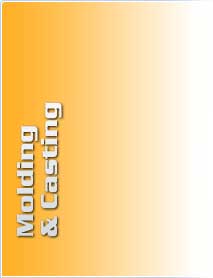

Room Temperature Vulcanization (RTV) molds are the fastest, most accurate, and least expensive way to create one and up to hundreds of duplicates of a prototype part. Rubber molds can faithfully duplicate details and textures present on the original part, and can be very forgiving of part geometry when it comes time to remove it from the mold.
A master pattern, such as a Stereolithography (SLA) part, is used to form the rubber mold. The SLA part may be oversized to compensate for shrink rates. After customer approval, the SLA master part is hand-finished to a high level, on all exterior surfaces. Texturing, if required, is also done at this time. The master pattern is then surrounded by a parting surface that establishes the parting line of the mold. The liquid RTV rubber is poured over the pattern and parting surface combination. Once the rubber has solidified, the parting block is removed and the rubber is poured over the pattern and mold half combination. The pattern is removed to yield the mold halves of a rubber tool.
Curing time for the mold is dependent on the product and curing agent. Times range from 30 minutes to over 40 hours. Adding heat will speed up the curing process. Liquid urethanes, thermoset materials, are then poured or injected into the rubber mold. After the urethane cures and solidifies, the RTV tool is then separated to remove the cast urethane prototype.
Time and Production Rates
A master pattern, such as a Stereolithography (SLA) part, is used to form the rubber mold. The SLA part may be oversized to compensate for shrink rates. After customer approval, the SLA master part is hand-finished to a high level, on all exterior surfaces. Texturing, if required, is also done at this time. The master pattern is then surrounded by a parting surface that establishes the parting line of the mold. The liquid RTV rubber is poured over the pattern and parting surface combination. Once the rubber has solidified, the parting block is removed and the rubber is poured over the pattern and mold half combination. The pattern is removed to yield the mold halves of a rubber tool.
Curing time for the mold is dependent on the product and curing agent. Times range from 30 minutes to over 40 hours. Adding heat will speed up the curing process. Liquid urethanes, thermoset materials, are then poured or injected into the rubber mold. After the urethane cures and solidifies, the RTV tool is then separated to remove the cast urethane prototype.
Time and Production Rates
- The production rate from RTV mold to first part: 5-10 business days after customer approval of SLA Master pattern.
- Typically a mold can be shot 1-3 times per day.
- A typical mold can be used 10-25 times before breakdown of the RTV material.
